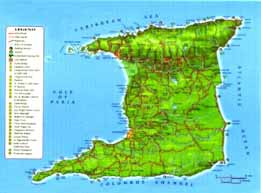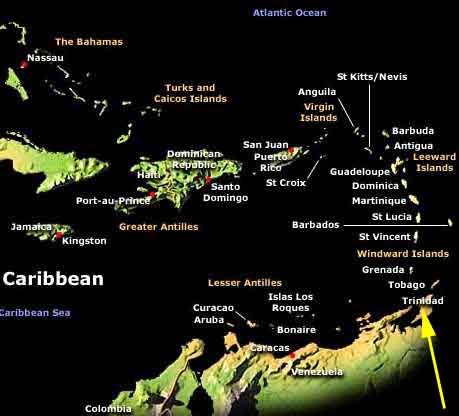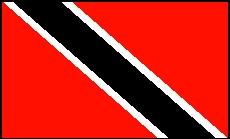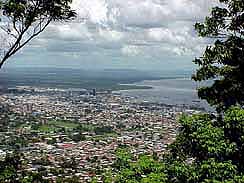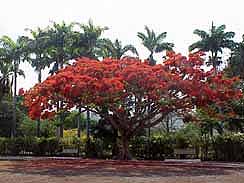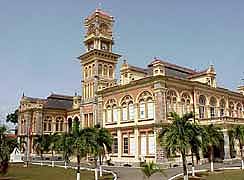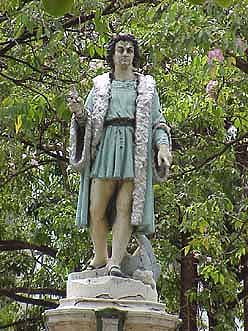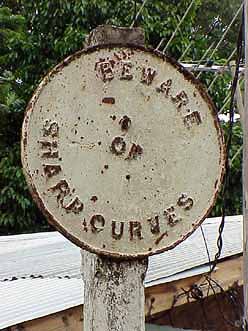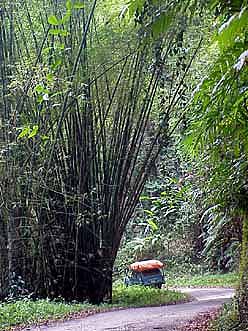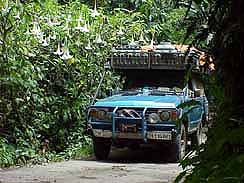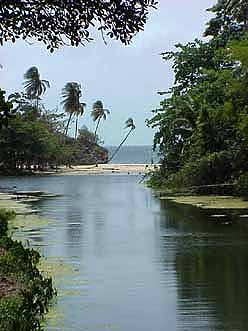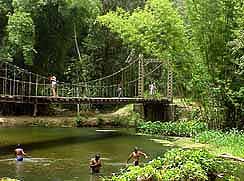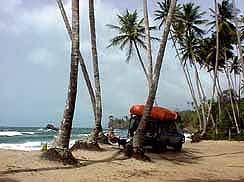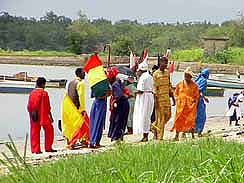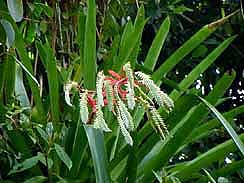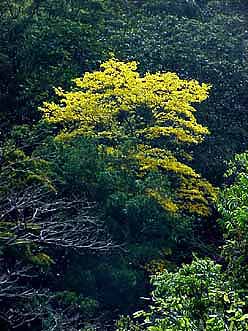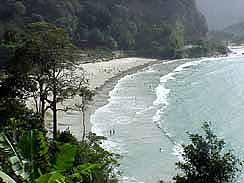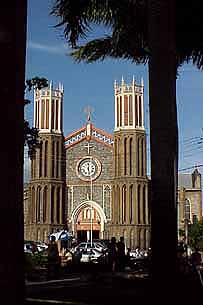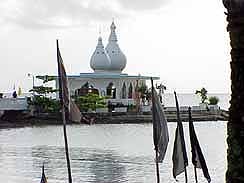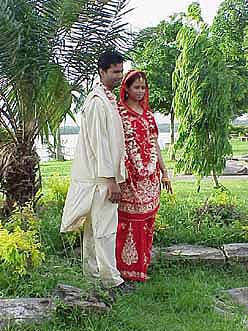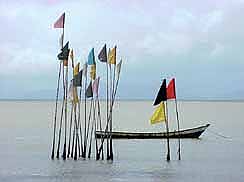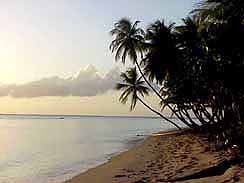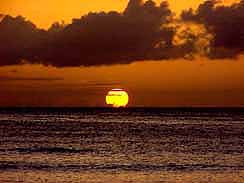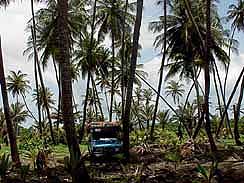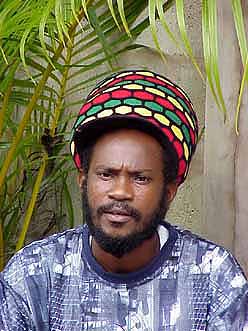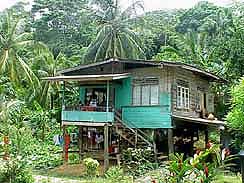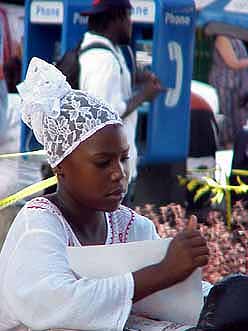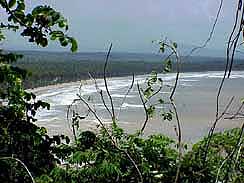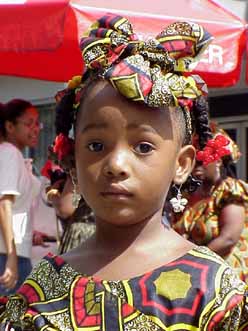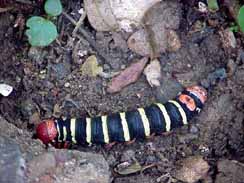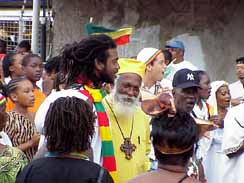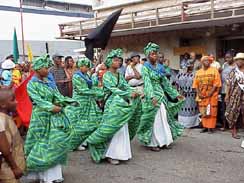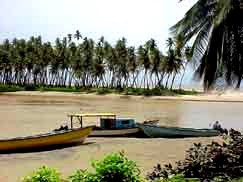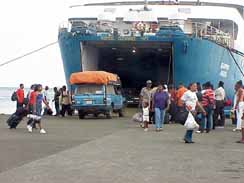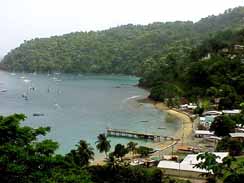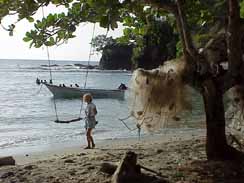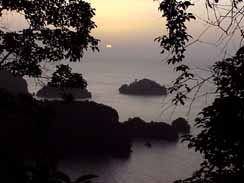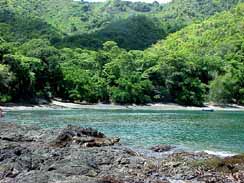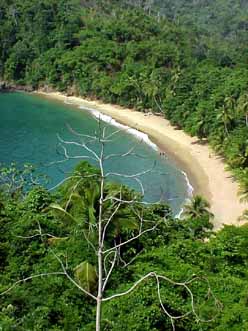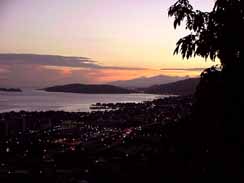![]()
Enjoy some pictures of the worldrecordtour, taken in Trinidad & Tobago
Trinidad Map
|
Tobago Map |
Map of the Caribbean |
|
|
|
|
|
||
|
|
|
||
| Trinidad &
Tobago - "Home of the Calypso"
|
||||
|
|
|
||
| It is still night, as on May 22nd, at 4am, “MV Husum” reaches the harbor of Port-of-Spain in Trinidad. Shortly afterwards, it knocks on our door – the immigration officer is already on board and wants to see us. At least it is only a short procedure and after five minutes we can go back to sleep. We are quite happy with the three month’s stay stamped into our passports. Luckily there was no question about any return or onward ticket. Of course, we are now very anxious about the entry procedures for our LandCruiser. That islands are all but easy for cars in this hemisphere, even only for a temporary tourist import, has shown already the Dominican Republic, where we had to fight for four days with all kind of absurd laws and wide spread corruption. But here we are confident that it will be an easy matter, as Trinidad takes part with the “Carnet de Passage”, a customs agreement between countries which guarantees the re-export of a vehicle. But what is an agreement standing for if an arrogant customs comptroller does not care what his government before him signed in 1954? He insists firmly that now other rules apply and that a bond has to be placed, which after complicated calculations is fixed at US$ 5’000. We are completely knocked down the more that we organized all the other necessary car entry documents well in advance with the help of Toyota Trinidad. Also the Trinidadian Automobile Association, where we hope to get support, cannot help us. They just promise to make a complaint and offer us a free towing service - if ever needed! Luckily Toyota Trinidad agrees to place the bond for us. Until the whole bureaucracy is finalized, it takes three full days. One day alone is needed for the licensing. For driving around Trinidad, a local license plate is required. The same was already the case before in Egypt and Libya. We get number V 419 and have to order ourselves the plate privately – red numbers on white ground.
|
||||
|
|
|
||
| The welcome at Toyota Trinidad is warm and full of surprises. In the first place, we are put into a small personal guesthouse called “Simple Escape” for seven nights. Then they offer to repair our gearbox which makes funny noises already since Brazil. While the work is done for free, the spare parts however will go to our account. Who might have them on stock is now the difficult question. We are soon faced with the fact that getting spare parts for our “oldie” is becoming more and more difficult. Therefore, we try to take advantage of our good contacts too. Amazingly, it just needs an email to Suresh Rampersad, the General Manager of Toyota Guyana, to be successful. Apparently, he has all the required pieces on stock. It is astonishing that this forgotten small country in the Northeast corner of South America has such an endless stock of FJ60 parts. Now, we just have to wait until they have found their way to Trinidad.
|
||||
|
|
|
||
| In the meantime, we have plenty of time to stroll around Port-of-Spain with its 350’000 inhabitants. This cosmopolitan town on the Golf of Paria, nestled between tropical hills, gains our sympathy immediately. An incredible large mixture of ethnic groups fills the crowded streets. Outstanding are the many Rastafarians with their distinguished hairstyle and headdress, which add very much to the special Caribbean flair of the city. But unfortunately they present also the majority of beggars, drug addicts and homeless people. Apart from a minority of Chinese and European, most of the ethnic groups of Trinidad & Tobago’s population of 1.3 Mio people are Africans (40%), Indians (40%) and mixed (18%) - all descendants of imported workers for the sugar plantations during the slavery. Criminality is very high, mainly drug related. Many regions are “no-go-areas”, the same as in Guyana and Jamaica. The Government of Trinidad has taken necessary steps to get the situation more under control by allowing the police to apply “shoot to kill”, i.e. criminals who are trying to flee or offer resistance may be killed. Despite of all, we do not feel in any way uncomfortable or threatened. People are open, interested and kind towards us, especially after they have seen us on TV or read about us in the newspapers. There is a constant honking, waving, calling, shaking hands and welcoming us – it is a good feeling! What we enjoy the most is the region around the Queen’s Park Savannah – the “Central Park” of Port-of-Spain. At present all the red flamboyant trees are in full bloom – a most beautiful sight. And opposite, at Maraval Street, we can admire the stunning “Magnificent Seven” – a range of different buildings with distinctive, unique and nostalgic architecture.
|
||||
|
|
|
||
| The repair of our gear box makes very slow progress. From one week it takes two, then four, then six – this is exactly the time until our jacked-up LandCruiser is on its own wheels again. Unfortunately, it showed that the main noise did not come only from the gear box, but from the differential too. The two bearings of the pinion were completely worn out, and the small gears had practically no more teeth – no wonder after 582’000 km (obviously also the differential looses its teeth in the age). Therefore, additional spare parts have to be found and flown in what delays everything further. The crazy thing is that Toyota continues to pay the guesthouse for us – totally 47 (!) days – what in the beginning we really enjoyed, but after a certain time, makes “the roof fall on our heads”. Without our car we are lost, cannot do much. During the day it is too hot to walk and in the cooler evening hours, it is too dangerous.
|
||||
|
|
|
||
| What did we do during the several weeks without our “freedom machine”? We invested around 80% of the time into the logistics for our planned “Cruise” through the Caribbean Islands. It was a constant up and down. Often, we found ourselves in front of an impenetrable wall, when ministries of tourism and shipping lines, which we approached, neither reacted to emails nor to faxes and we did not make any progress at all. Occasionally, we had a break-through, but soon new problems popped up and the whole project was uncertain again. It was pretty frustrating. What makes the issue also complicated is that we have to rely always on public phones, and mostly they are situated on very noisy traffic roads or are out of order. And only phoning brings results! But finally, after much initiative, endurance, persistence and patience our “Cruise through the Caribbean with our LandCruiser” begins to take shape. The ministries of tourism of Grenada, St. Vincent, Barbados, St. Lucia, Dominica, St. Kitts and Jamaica agreed all to facilitate the temporary import of our car and wave the usually obligatory bond. Also some ferries and small ‘banana boats’ finally answered surprisingly cooperative and supportive, so that our confidence grows that we will be finally able to make it! Only the connection between St. Lucia and Martinique is still missing, but we are confident to find – once being on the place – a suitable solution. We experienced repeatedly that many possibilities are to be found only locally.
|
||||
|
|
|
||
| We are anxious for action, when finally our LandCruiser gets out of the Toyota work shop. Our first tour leads us to the Northwest, where the tropical cloud forest and the sandy beaches meet all the way from Maracas to Blanchisseuse. Already crossing the densely forested coastal range from Port-of-Spain to Maracas is impressive, but from Arima to Blanchisseuse it is a real experience. There, a small, paved one lane roads winds up hill in many curves and passes through the Asa Wright Nature Centre - a breathtaking tropical world with bamboo forests, giant trees, moss, lobelias and a big variety of colorful plants and flowers in such an abundance and concentration, we never have seen before. And we are always surrounded by the never ending singing of tropical birds – far more intensive than in the humid rain forest of the three Guyanas. We need four hours for the 22 miles to the coast at Blanchisseuse, because we always stop to admire all the beauty. Blanchisseuse with its idyllic Marianne River and the beautiful beach with the bended palm trees is the most Northerly spot which can be reached by car – and for us also the most beautiful and quiet one. Here, the road ends abruptly towards the East (direction Matelot). And it is just this part which is said to be the most original.
|
||||
|
|
|
||
| We decide therefore to approach it the other day from the Northeast. And we do not regret it. It is indeed a remote place with wild shores. We enjoy sitting alone on a rock at the white lighthouse of Galera Point in Toco and listen to the breaking waves. And we enjoy driving on the deserted narrow island roads towards Matelot. Sometimes, it is following the coast, sometimes inland through dense rain forest with some not very reliable looking bridges to cross. Now and then, we spot a lonely, simple wooden house on stilts with some attractive pots filled with tropical flowers between all the green. Besides that, all we see is just impenetrable jungle all over. Grand Riviere, a small coastal settlement, is the place where the giant leatherback turtles come ashore. We notice some fresh deep holes in the sand and scattered white egg shells all around – probably the work of wild dogs? As we were able already in French Guiana some weeks ago to watch these turtles emerge from the dark Atlantic waves onto the beach and slowly haul themselves up the sloping sand to dig their holes and lay their eggs, we do not want to spend the night alone in this solitude and continue to Matelot, where the road ends at a wide river. Here, we feel really at the “end of the world” and never expected to meet in this remote corner a Swiss guy from Basle. He tells us that he is married since 10 years with a Trinidadian and is renting out two holiday bungalows in the region. Drinking a cold beer, we talk and talk until dark clouds remind us to get on the move again. Shortly after, it starts to poor down heavily and soon the street turns into a riverbed. We are glad to find a big parking lot in a guarded village school where we are allowed to spend the night and use even the showers.
|
||||
|
|
|
||
| A totally different experience is the West Coast. There, we often have the feeling of being transferred to India. Everywhere are Hindu prayer flags swaying in the wind – in front of houses or fixed in groups on bamboo sticks in the coastal water. A beautiful sight is the Waterloo Hindu Temple with its two white onion shaped towers, which can be seen already from far away. Built in the water and surrounded by a lovely park, it is a very outstanding worshipping place. On the parking area is the monument of its builder, a “Sadhi”, inaugurated in 1995 on the occasion of the 150-year anniversary of Indian immigrants. A special splendor is added when a wedding party approaches and makes its way to the main temple. More to the South, at Cangrejos Bay, where we stop for lunch, it feels rather like Africa. Firstly we see just a group of people dressed in traditional African costumes. Only later we find out that they came to baptize brothers of their congregation in the sea. We will be able to share this experience also in the future all over the Caribbean islands. Trinidad is not a true tourist destination. Trinidad’s income is from oil and asphalt. The miracle the “Trinis” count to the Seven Wonders of the World is called “Pitch Lake”. It is 135 feet deep and produces constantly black asphalt. Many roads were and are still built by this never stopping supply. For the eye, it is rather disappointing. The pond is not bigger than a middle sized football field. And being the rainy season now, it is covered with water, so that there is absolutely nothing exciting to see. That Trinidad is not a tourist destination is also reflected by the many dirty beaches. It hurts the feeling to see the piles of garbage everywhere as we drive along the beautiful scenery of the East coast towards Manzanilla with miles and miles of sandy and coconut tree fringed beaches. It would be such a lovely, romantic place – but unfortunately just would be! How people can feel comfortable in such surroundings, will always be a big question mark to us.
|
||||
|
|
|
||
| But on Tobago, the “Robinson Crusoe Island” and birth place of Harry Belafonte, it is different, everything is appealing, everything is clean. Life on this 116 sq.miles small island is calm, relaxed and especially also safe. From the very first moment as we land in Scarborough with “MVBeauport” from Trinidad, we know that we easily could remain much longer than the couple of days we have planned. According to the legend, the Swiss family Robinson stranded here after being shipwrecked - we wonder on which of the many bays? They are all beautiful and mostly deserted. At King Peter’s and Culloden Bay we share the secluded beach with screeching sea-gulls only, just like in Robinson’s times! Very beautiful is also Englishman’s Bay nestling like a pearl white crescent between the deep green rainforest and the blue sea. But there, souvenir vendors have already pitched up their stalls. Tobago is surprisingly not crowded with tourists yet. The big hotel resorts are concentrated at Crown Point in the Southwest Corner close to the famous beach at Pigeon Point which we nicknamed the “White Ghetto” due to the mostly white faces, who do not mind to pay an entry fee on beaches. But it is easy to find a small personal hotel; they are spread all over the tropical island. We spend our nights at the Toyota distributor in Scarborough in green surroundings with frogs concerting from sunset to dawn.
|
||||
|
|
|
||
| We are just in time back in Trinidad– now with the “MV Panorama” – to take part at the “Emancipation Day” on August 1st, which brings us back immediately into deep Africa. At this date in 1834, the British Parliament abolished the slavery. This historical moment is now celebrated each year by the descendents of African slaves with a big procession through the Independence Square. They gather in the capital by the thousands from all over the island. Not even on the black continent itself we have seen such a huge variety of traditional and colorful costumes as the singing and dancing crowd follows the magic beat of the steel pans, which are so typically Caribbean and said to be originating from Trinidad. By the way, a steel band consists of around 100 drummers. Each of them plays on up to six pans (oil drums). There is no one who does not drift in and out of the rhythms. For us it is an unforgettable experience which makes up a little bit for the barely missed Trinidadian Carnival - after Rio de Janeiro the second important in the world. On the same day, in the evening, we are guests of our Honorary Consul as Switzerland celebrates its National Day. Around 70 Swiss citizens assemble in her beautiful garden, mostly mixed couples. The most interesting guest for us is an archbishop from the canton of Valais, who accompanied Pope John Paul II on 45 trips around the world and spent his last years in Burundi in Central Africa. The most warmhearted is Trudi, a Swiss lady from Barbados, who invites us if we ever make it to her island (we did make it and spent many happy hours in her company). The most important is the Trinidadian immigration boss who offers us spontaneously to extend our permit to stay. No - eleven weeks are really enough, despite that we are feeling always very comfortable among these welcoming, friendly nation. As the speech of President Couchepin of the Federal Republic of Switzerland and our national anthem are broadcasted, it gets suddenly very silent and also a bit emotional. And we cannot deny that despite of being “world citizens” now, we still feel some patriotism in our hearts.
|
||||
|
|
|
||
| Eight days later, we board the comfortable car ferry “MV Panorama” again, this time not to Tobago, but to Grenada, thanks to Patrick Arnold, President of the Pan-Trinbago Carnival Organization. He spontaneously agreed to take our LandCruiser and us with the chartered party ferry on August 9th to the Carnival of Grenada. All three of us are in very good company as we leave Port-of-Spain, the city which never sleeps: Our car parked between the oil drums and we among the 600 cheerful “Trinis” crazy for carnival. The flag on Fort George – the hill above the city -, where we enjoyed the stunning view during numerous breakfasts, is swaying very strongly in the wind waving good-bye.
|
||||
|
|
|
||
|
||||
